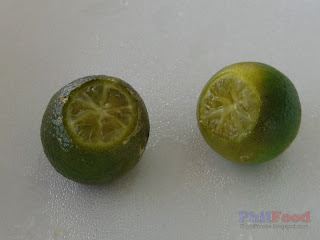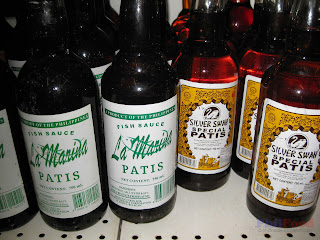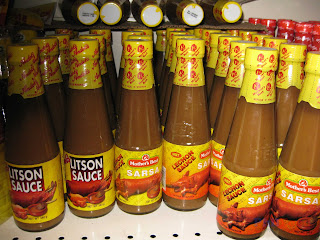List of Rice Varieties in the Philippines
A few of the popular varieties found and sold in local markets:
- Dinurado / Denorado
- Intan
- Milagrosa
- Sinandomeng
- Wag-Wag
- C4 (UPLB C4-63G)
- IR36
- IR42
- IR64
Some less known:
- Angelica (NSIC Rc 122)
- Apostol
- Azmil
- Azucena
- Balatinao
- Baysilanon
- Bigante
- Binirhen
- Binicol
- Binulawan
- Bugos
- Bunto Kabayo
- Burdagol
- Chayong
- Davao
- Delhlinla
- Dinalaga
- Dumali
- Elon-elon
- Ennano
- Fortuna
- Ginilingan Puti
- Guinangang
- Inadhica
- Inuruban
- Kalinayan
- Kasungsung
- Kinanda
- Kinastano
- Macan I
- Macan Binundok
- Macaraniag
- Magilas
- Magsanaya
- Makapilay pusa
- Mangarez
- Masipag
- Milbuen
- Milfor
- Milketan
- Mimis
- Palawan
- Pampanga
- PARC-2
- Rinara
- Rizalina
- Santa Rita
- Sigadis Milagrosa
- Sinampablo
- Sinampaga Selection
- Smaguing
- Taducan
- Tinawon
Rice in the Philippines is called
bigas when uncooked and
kanin when cooked. Glutinous rice is referred to as
malagkit (sticky). Unmilled rice is
palay. Rice is the staple food in the Philippines supplying about 35% of the average Filipino's daily caloric intake. Aside from plain steamed rice, there are many Filipino rice recipes, rice snacks and desserts. Even the water that has been used to wash rice, called
hugas bigas, is sometimes called for in Filipino recipes aside from other uses such as an electrolyte mixture to combat diarrhea and as a fertilizer.
The history of Philippine rice farming dates back to antiquity and has left a legacy etched into the very fabric of Filipino culture, perhaps most vividly manifest in the majestic Philippine rice terraces carved into the rocks of the northern Philippines. They are symbolic both of the importance and difficulties faced in growing rice in the country. While the Philippines is heavily reliant on rice, its mountainous terrain is not well-suited to rice cultivation placing obstacles to Philippine rice production. This and its fast growing population have contributed in making the country the largest rice importer in recent years, despite being the eighth largest rice producer. With Philippine rice shortages and rising world rice prices, food security is a concern driving rice research into high-yield rice and tougher more resistant hybrid rice varieties in the Philippines.
There are many different strains of rice—the
International Rice Genebank is reputed to hold over 112,000 different specimens of rice varieties from all over the world—but only a small fraction of these have the requisite traits that make them attractive to plant commercially. In the Philippines there are indigenous medium grain tropical japonica
("javanica") varieties and long grain indica rice varieties.
Nomenclature
Traditional Filipino varieties of rice are referred to by their traditional names. Several institutions have been involved in the development of rice varieties in the Philippines and their names are sometimes referenced in the designation of rice species, especially those of older rice varieties. Rice varieties with designations starting with IR such as IR64 were bred by the
International Rice Research Institute (IRRI); UPL or UPLB refers to the University of the Philippines, Los Baños; and BPI refers to the
Bureau of Plant Industry, Department of Agriculture Philippines. The
Philippine Rice Research Institute (PhilRice) is another branch of the Department of Agriculture involved in developing rice in the country.
The release of rice varieties in the Philippines became more systematized over the years with the Philippine Seed Board (PSB), now the
National Seed Industry Council (NSIC), eventually empowered to conduct the releasing process. The NSIC tests seeds submitted to it and then formally releases those which pass its criteria giving them a designation that was earlier in the form
PSB Rc, but has now changed to
NSIC Rc. This coding practice has been in use since 1990 and applies to newer rice varieties. Rice varieties most suitable for lowland areas are even numbered while those considered best for upland areas are designated with odd numbers. More conventional names are often associated with the PSB technical code, with names of rivers and lakes being applied to the lowland varieties and names of mountains for those for upland use. Sometimes popular names given by Philippine rice farmers have been adopted.
More recently the NSIC naming code has dropped the usage of names of bodies of water and mountains and has instead adopted the descriptive terms
Japonica, Mabango, Malagkit,
Matatag,
Mestiso,
Sahod Ulan,
Salinas,
Submarino, and
Tubigan to refer to japonica, aromatic, glutinous, tungro-resistant, hybrid, rainfed lowland, saline, flooded lowland, and irrigated lowland rice varieties respectively.
Notes
Aside from the usual long grain white rice, local brown rice, red rice, and black rice can be found in supermarkets although wild rice (which is not properly a rice at all) is harder to find. Previously, rice sold in local markets as often as not was badly milled with many sand and gravel particles or old rice husks mixed in. This made it easy for imported foreign rice, mainly from Thailand but also Japan and the United States, to develop a reputation for superior quality. Fortunately the local situation has improved dramatically in recent years with a rise in milling standards. One is now better able to appreciate and compare the intrinsic qualities of the local varieties of rice without being distracted by extraneous considerations. The focus in rice research has also expanded to include more the factors that go into good table qualities and not just those that increase rice yield resulting in new hybrid varieties for sale.
The general impression I have is that while imported rice varieties can often be more fragrant, very aromatic rice tends to become spoiled (
panis) more easily if left in the hot and humid climate of the country too long. The table qualities are otherwise pretty comparable and a matter of personal preference.
Milagrosa: Miracle Rice Marketing?
For a long time I was under the impression the Thai rice being sold was a local variety because
milagrosa, the name of an aromatic traditional Philippine rice variety which also translates from Spanish as
miracle or
miraculous ergo "miracle rice", was usually written in bold on the sacks of rice from Thailand. Further confusing things was the use of the term "miracle rice" for the breakthrough IRRI variety IR8, a high yielding rice variety resulting from the cross of the Indonesian
peta with the Taiwanese semi-dwarf
deegeowoogen (DGWG) that is credited with ushering in a green revolution. I now suspect that the
milagrosa labeling was probably just a marketing ploy to appeal to Filipino rice consumers familiar with the Philippine
milagrosa variety. These days sacks of rice from Thailand have largely dropped the name
milagrosa from their bags and instead the term "jasmine rice" or
Thai hom mali, which is from what I can gather possibly the variety of rice used all along, is promoted.
Consulted sources conflict on whether
milagrosa is an indica variety like most imported Thai rice or a tropical japonica. My own experience with
milagrosa rice from a Philippine supplier is that it has a greater tendency to retain water and end up sticky leading me to think that it is a tropical japonica variety.
Common Market Varieties
Among local varieties,
milagrosa has a high reputation going back many years. If going by price as an indicator of quality, then of the common local premium varieties offered by a number of suppliers,
milagrosa is followed by
dinurado which is generally more highly regarded than
sinandomeng, which is then followed by
wag-wag, C4, and other unnamed varieties. To be truthful I'd have a hard time trying to distinguish between them and would consider the supplier or brand a more important basis of differentiation. It may be just as well. According to surveys conducted to determine the most popular varieties for rice planting, many of the IRRI rice cultivars and those named by the NSIC composed the vast majority of rice planted. This would seem to be at odds with the experience at market where a large proportion of rice supplied by Philippine rice traders are labeled as popular traditional varieties.
More Rice
Other varieties of local rice not carried by multiple branded suppliers have become increasingly available for Philippine rice buyers. Ifugao rice was purchased one time when it went on sale and was found to be good quality and kept very well; the retail price almost doubled shortly after.
With more quality Philippine rice grains, Indian basmati rice joining the fray, and an increased interest in alternative grains driven by health concerns about white rice, trying all the varieties of rice out instead of sticking to one has become a more appealing option.
This while rice imports overall have declined because a substantial portion of imported rice was imported by the government for food security. This rice is made available by the National Food Authority (NFA) with a lot of the NFA rice sourced from Vietnam.
Brands
The rice available comes from a broad range of suppliers with most local brands having only spotty presence across supermarkets. Brands found in one supermarket chain may be absent in another. In wet markets rice is often taken out of the sack and sold per kilo with variety of rice instead of brand of producer being the discriminating factor.
The following local brands have some consistency in presence:
Best Choice - Tantrik Trading - 2140 Onyx St., Sta Ana, Manila
Doña Maria - SL Agritech Corporation - sl-agritech.com
Golden Grains - R.E.F. Commercial Corp.
Harvester's - Sunnywood Corp. - sunnywoodrice.com
Highlands Rice - highlands_rice@yahoo.com
Ifugao Rice - Oliver Enterprises - Talavera, Nueva Ecija - oliverricemill@yahoo.com - 044-456-5001, 044-456-0508, 0917-566-2249
Mrs. Lam - ECT Enterprises - Malaking Ambling, Magdalena, Laguna - 0922-838-8365 - ectent@yahoo.com
Vita-Rice - Golden Season Grains Center Inc. - Dadap, Luna, Isabela - gsgci.com - inquiry@gsgci.com - 0917-530-9988
More information
- About Rice. (n.d.). International Rice Research Institute (IRRI).
- Bureau of Agricultural Statistics. (January 2012). Rice and Corn – Situation and Outlook Vol. 26 No. 1. ISSN-2012-0346.
- Castillo, Gelia T. (March 23, 2008). Rice production, population, and natural resources endowments. The Manila Bulletin.
- Dalrymple, Dana G. (1986). Development and Spread of High-Yielding Rice Varieties in Developing Countries. Washington D.C.: Agency for International Development.
- de Leon, John C. (2005). Rice that Filipinos Grow and Eat (Discussion Paper Series No. 2005-11). Philippine Institute for Development Studies.
- FAQs on Philippine Seedboard (PSB)/NSIC Rice Varieties. (April 28, 2010). Pinoy Rice Knowledge Bank.
- Flores, Helen. (September 10, 2009). Rice varieties that can withstand drought, floods being developed. The Philippine Star.
- Garris, Amanda J., Thomas H. Tai, Jason Coburn, Steve Kresovich, and Susan McCouch. (January 16, 2005). Genetic Structure and Diversity in Oryza sativa L. Genetics 169 (3) 1631–1638.
- In 23 Years, PhilRice Bred 28 Rice Varieties. (November 22, 2008). Agriculture Business Week.
- International Year of Rice 2004 – About Rice: Philippines. (2004). FAO.
- Olsen, Kenneth M. and Michael D. Purugganan. (October 2002). Molecular Evidence on the Origin and Evolution of Glutinous Rice. Genetics 162 (2) 941–950.
- Peng et al. (March–April 2000). Grain Yield of Rice Cultivars and Lines Developed in the Philippines since 1966. Crop Science, 40(2): 307–314.
- Philippine Rice Research Institute. Department of Agriculture. (1997) Characteristics of Popular Philippine Rice Varieties. Rice Technology Bulletin No. 19.
- PhilRice Seed Stock – Seeds for Sale – All Varieties – Philippine Seedboard (PSB) / NSIC Varieties. (n.d.). Philippine Rice Research Institute (PhilRice).
- Why Does the Philippines Import Rice? (July 12, 2011). International Rice Research Institute (IRRI).
































